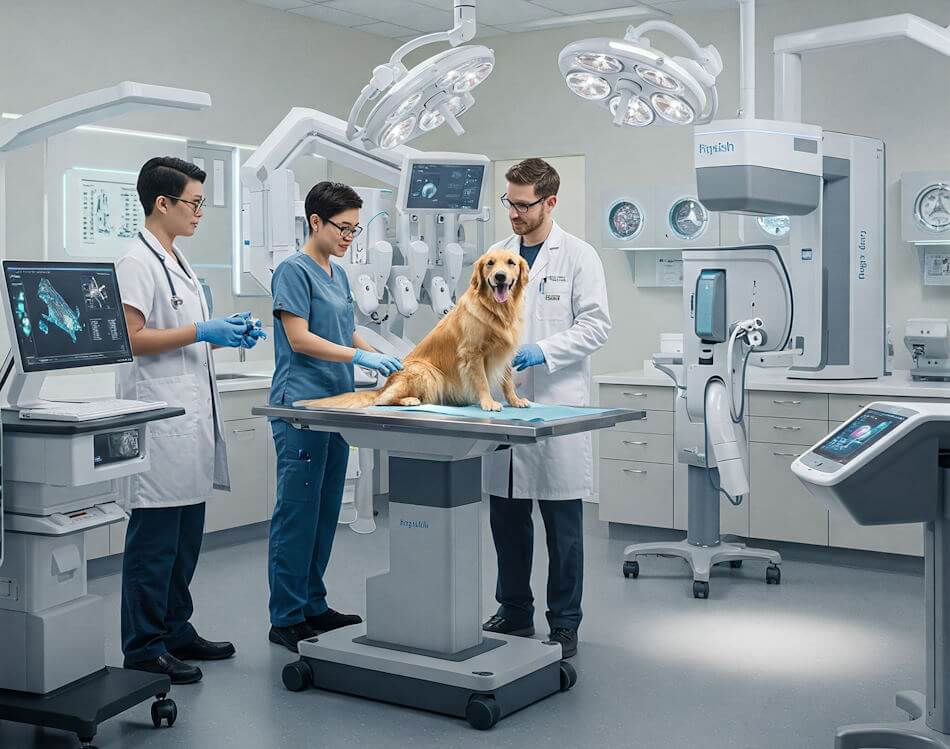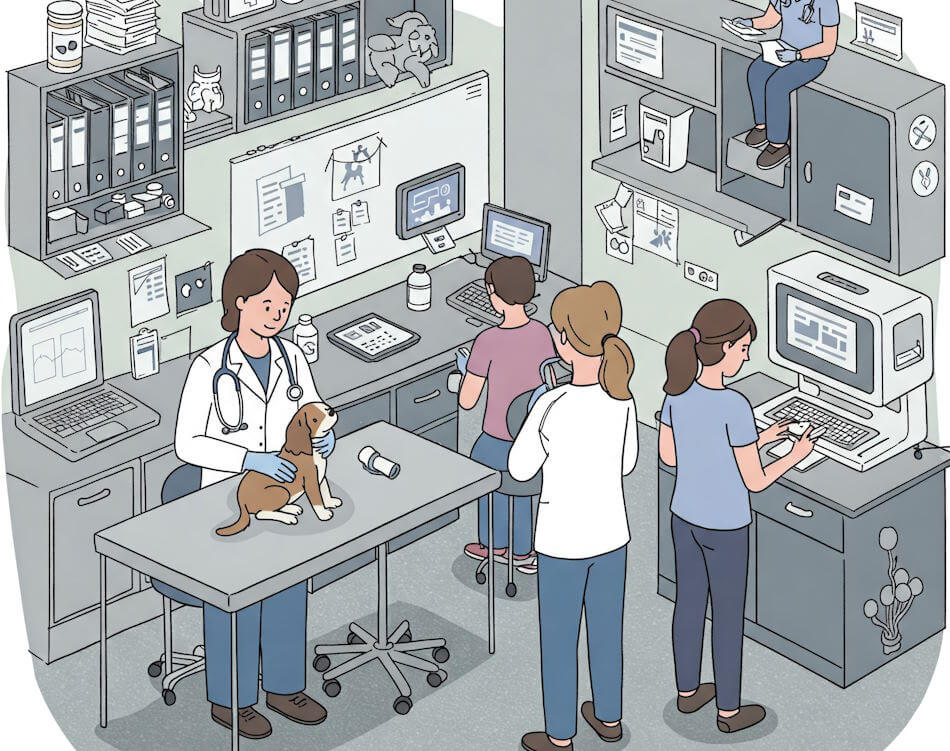Veterinary medicine is a highly rewarding yet challenging field, often characterized by unique sources of workplace stress that can significantly impact professionals in this sector. One of the primary contributors to stress among veterinary professionals is the emotional interaction with animals and their owners. The bond between pets and their owners can intensify feelings of responsibility, particularly during difficult diagnoses, treatment plans, or end-of-life decisions. This emotional burden is compounded by the compassionate nature of veterinary work, leading practitioners to experience heightened stress levels as they navigate these sensitive situations.
Another prevalent source of stress in veterinary practices is the extended working hours that many professionals face. Long shifts, coupled with the demands of emergencies and surgeries, can lead to physical exhaustion and mental fatigue. In fact, studies indicate that veterinary professionals rank high in fatigue-related work grievances, facing not just a rigorous schedule, but also the weight of complex medical decisions that persist even after hours.
The expectations surrounding quality pet care can further exacerbate workplace stress within the veterinary field. With the increasing emphasis on high standards of care, veterinary professionals often feel pressure to maintain a perfect track record, which can lead to anxiety and burnout. Research has shown that nearly 45% of veterinarians experience stress that could adversely affect their mental health, underlining the need for awareness and coping strategies within this specialty.
Moreover, the prevalence of compassion fatigue is another vital concern. As individuals routinely engage with suffering animals and distressed owners, the risk of emotional exhaustion increases, leading to a decline in job satisfaction and overall well-being. Understanding these unique stressors is essential for fostering a supportive work environment in veterinary medicine, thus enabling professionals to provide the best possible care while maintaining their own health.
Recognizing the Signs of Stress in Veterinary Staff
In the high-pressure environment of veterinary medicine, recognizing the signs of stress among staff is crucial for maintaining a healthy workplace. Veterinary professionals may experience a range of physical, emotional, and behavioral symptoms that can potentially hinder their performance and overall well-being. Awareness of these signs can lead to early intervention and support, creating a more sustainable work environment.
Physically, stress can manifest in several ways, including chronic fatigue, headaches, and gastrointestinal issues. These symptoms may not only affect individual health but can also lead to decreased productivity and job satisfaction. Additionally, frequent colds and illnesses might indicate a weakened immune system due to prolonged stress. It is essential for veterinary staff to pay attention to these physical indicators, as they may signal a need for change in their work-life balance.
Emotionally, signs of stress may include irritability, anxiety, and feelings of overwhelm. Veterinary staff may find themselves more prone to mood swings or feeling detached from their work, a common symptom of burnout. It is vital for individuals to recognize these emotional responses and consider reaching out for support, whether through peers, supervisors, or mental health professionals. Self-awareness around emotional health can catalyze positive changes in coping strategies.
Behavioral signs are equally significant. Changes in work performance, increased absenteeism, or withdrawal from colleagues may indicate underlying stress. Veterinary staff experiencing these changes should reflect on their current workload and seek to communicate any overwhelming pressures with their team. Open dialogue about stress management can foster an environment of support and shared responsibility, benefiting everyone involved.
Identifying the signs of stress early can make a considerable difference in the well-being of veterinary staff. By promoting self-awareness and encouraging an open approach to mental health, the veterinary community can mitigate the adverse effects of stress and enhance overall job satisfaction.
Creating a Supportive Work Environment
In veterinary medicine, creating a supportive work environment is essential for maintaining both staff well-being and optimal patient care. Open communication serves as the foundation of a transparent workplace where team members feel valued and heard. Encouraging staff to share their thoughts, concerns, and ideas fosters a culture of collaboration. Regular team meetings and feedback sessions can enhance this dialogue, ensuring that everyone remains aligned with the clinic’s mission and goals while providing a platform for addressing any issues that may arise.
Another effective strategy for cultivating a supportive atmosphere is through team-building activities. These initiatives, which can include both formal and informal events, are instrumental in strengthening relationships among team members. Activities can range from professional development workshops to social gatherings outside of work. By engaging in these experiences together, staff members can build trust and camaraderie, leading to improved morale and an overall healthier work environment. Such initiatives not only fortify interpersonal bonds but also encourage a sense of belonging, which is vital in high-pressure fields like veterinary medicine.
Flexible scheduling is also a crucial component in creating a supportive workplace. Veterinary professionals often confront demanding workloads, and accommodating various staff needs can significantly reduce stress. Clinics can adopt varied approaches to scheduling, such as offering part-time shifts or altering work hours to better suit individual lifestyles. By allowing employees to negotiate their schedules, clinics demonstrate a commitment to work-life balance, thus enhancing job satisfaction and retention rates. This flexibility not only helps in managing workplace stress but also promotes a culture of respect and understanding among staff.
Implementing Stress Management Techniques
Veterinary professionals often face a high-stress work environment due to the emotional and physical demands of their profession. Implementing effective stress management techniques can significantly enhance emotional well-being and overall job satisfaction. One powerful approach is the practice of mindfulness, which involves being present in the moment and acknowledging thoughts and feelings without judgment. Mindfulness can be practiced through daily meditation sessions or simply by taking quiet time to focus on breath and sensations. This technique not only reduces anxiety but also fosters empathy, a critical trait for veterinarians.
Another effective method for managing stress is through breathing exercises. These exercises can be particularly beneficial during moments of acute stress, as they help stabilize the mind and body. Simple techniques, such as the 4-7-8 breathing method, involve inhaling for four seconds, holding the breath for seven seconds, and exhaling for eight seconds. Regular practice can lead to improved focus, reduced heart rate, and a greater sense of calm. Integrating these exercises into a daily routine can serve as a quick and effective way to counter long-term workplace stress.
Additionally, time management skills play a crucial role in stress reduction. Veterinarians often juggle multiple tasks, appointments, and client communications. Implementing strategies such as prioritizing tasks, setting achievable goals, and utilizing digital calendars can significantly decrease feelings of being overwhelmed. By managing time efficiently, professionals can create a more balanced workflow and reduce the pressure associated with deadlines.
To further support stress management, developing a holistic approach that includes a supportive network of colleagues is essential. Sharing experiences, challenges, and coping strategies within a team can foster a positive work environment and encourage resilience. Overall, adopting these stress management techniques can lead to a healthier workplace and improved mental health for veterinary professionals.
Encouraging Open Communication and Teamwork
In the demanding field of veterinary medicine, open communication and effective teamwork are indispensable for mitigating workplace stress. Veterinary professionals often face high-pressure situations that require seamless collaboration among staff members to ensure animal welfare and client satisfaction. By fostering an environment where dialogue is encouraged, veterinary teams can significantly alleviate stress levels and enhance overall job satisfaction.
To facilitate open lines of communication, it is essential to establish regular team meetings. These gatherings allow staff to share their concerns, discuss clinical cases, and address potential conflicts before they escalate. Setting aside dedicated time for team discussions encourages all members to voice their opinions and suggestions, reinforcing a culture of respect and understanding. Moreover, incorporating team-building activities can further strengthen connections and mutual trust among colleagues, ultimately leading to improved teamwork.
Conflict resolution is also a crucial element in reducing workplace stress within veterinary teams. When disagreements arise, addressing them promptly and constructively is vital. Encouraging staff to approach conflicts as opportunities for growth can lead to more effective problem-solving and reinforce a collaborative spirit. Additionally, designating a neutral mediator within the team may provide a structured approach to resolving disputes, ensuring that all parties feel heard and respected.
Furthermore, fostering a culture of appreciation can also significantly influence team dynamics. Acknowledging individual contributions and celebrating team achievements cultivates a positive work atmosphere, encouraging veterinary professionals to perform their best. Providing constructive feedback often leads to personal and professional growth, promoting a sense of belonging and reducing isolation.
In conclusion, open communication and teamwork are integral strategies for managing workplace stress in veterinary medicine. By prioritizing these elements, veterinary teams can create a healthier work environment that benefits both staff and the animals in their care.
Utilizing Resources for Mental Health Support
In the demanding field of veterinary medicine, mental health resources play an essential role in alleviating workplace stress. Awareness of available support services is critical for veterinary professionals who may experience emotional and psychological distress due to the nature of their work. Counseling services, often provided by employee assistance programs (EAPs), offer confidential support from qualified mental health professionals. These services can be invaluable for individuals facing burnout, compassion fatigue, or other stress-related issues.
Additionally, support groups specifically tailored for veterinary staff provide a platform for sharing experiences and coping strategies. These groups foster a sense of community, allowing members to discuss their challenges in a safe and understanding environment. Networking with peers in similar situations can lead to significant emotional relief and practical advice on managing stress.
For immediate support, mental health hotlines are another resource available to veterinary professionals. These confidential, 24/7 services are essential for those in crisis or needing urgent assistance. While the availability of such resources might vary by location, many organizations within the veterinary field have established dedicated hotlines to address mental health concerns. Utilizing these resources demonstrates an acknowledgment of one’s mental health needs and reflects a proactive approach to managing workplace stress.
Importantly, the destigmatization of mental health conversations within the veterinary profession is necessary to encourage individuals to seek help. Fostering an environment where discussions about mental well-being are normalized can significantly impact the overall health of the workplace. It is crucial that veterinary staff feel empowered to address their mental health concerns openly, thus paving the way for a supportive culture that prioritizes mental wellness.
Work-Life Balance: Finding the Right Mix
The veterinary profession is renowned for its rewarding yet demanding nature, which can often lead to significant workplace stress. Therefore, maintaining a healthy work-life balance is essential for veterinary practitioners to enhance their mental well-being and reduce the risk of burnout. Establishing boundaries between professional responsibilities and personal life is vital for creating a sustainable work environment. This balance not only improves job satisfaction but also fosters long-term dedication to the field.
To prioritize personal time and achieve a feasible work-life balance, practitioners should first assess their existing schedules and responsibilities. Developing a clear understanding of one’s workload can help identify periods of excessive stress and create opportunities for improvement. Implementing time management techniques such as prioritizing tasks, utilizing scheduling tools, and breaking work into manageable segments can assist veterinarians in creating a more structured approach to their duties.
Setting clear boundaries is another critical aspect of establishing work-life balance. Veterinary professionals should communicate their availability to colleagues and clients, ensuring that personal time is respected. This may involve establishing specific hours for responding to emails or taking clinical calls, allowing for uninterrupted time dedicated to personal activities and relaxation. Additionally, incorporating regular breaks during work hours can help reduce stress levels and maintain productivity.
Engaging in activities that promote well-being outside of work can also reinforce balance. Veterinarians should consider pursuing hobbies, exercising, or participating in social activities that bring joy and fulfillment. Allocating time for self-care rituals and family interactions nurtures physical health and emotional resilience. In nurturing these personal aspects, veterinary practitioners can create a more balanced lifestyle, ultimately benefiting both their professional performance and personal satisfaction.
The Role of Veterinary Associations in Supporting Wellness
Veterinary associations play a pivotal role in promoting mental health and workplace wellness among veterinary professionals. Recognizing the unique challenges faced by those in this field, these organizations have developed various initiatives aimed at enhancing the overall quality of life for veterinarians and support staff. With increasing awareness of mental health issues within the veterinary profession, associations strive to provide a framework that supports emotional well-being and resilience.
One key initiative is the organized seminars and workshops that focus on stress management techniques specifically tailored for veterinary practitioners. These events often invite experts who share insights on coping mechanisms, time management, and effective communication strategies, which are essential in navigating the high-pressure environment of veterinary medicine. By providing educational resources, these associations empower members to develop skills that directly contribute to a healthier work-life balance.
In addition, many veterinary associations offer online resources, such as webinars and mental health toolkits, which are accessible at members’ convenience. These resources often include topics ranging from self-care practices to crisis intervention strategies, helping veterinary professionals recognize when they or their colleagues may need additional support. Moreover, associations frequently collaborate with mental health professionals to create referral networks, ensuring that members have access to appropriate counseling services.
Another significant initiative by these associations is the promotion of wellness programs that foster a supportive community among veterinary professionals. Peer support networks and mentorship opportunities not only enhance professional development but also cultivate a sense of belonging, reducing feelings of isolation that can often accompany the profession. By fostering connections and encouraging open dialogue about mental health, veterinary associations help create a culture of wellness in the workplace, ultimately leading to improved job satisfaction and performance.
Building Personal Resilience as a Veterinary Professional
Resilience is a fundamental attribute for veterinary professionals, enabling them to cope with the unique stresses of their work environment. Developing personal resilience can be achieved through a combination of effective strategies that focus on individual growth and support systems. One of the primary methods is goal-setting. By establishing clear, achievable goals, veterinary professionals can create a sense of direction and purpose. This process not only facilitates focus on essential tasks but also allows for celebrating small victories along the way, which can significantly boost morale and motivation.
Self-reflection serves as another powerful tool in building resilience. Taking time to evaluate personal and professional experiences can provide insights into stress triggers and coping mechanisms. By regularly engaging in self-reflection, individuals can identify patterns in their responses and adjust their strategies accordingly. This introspection fosters a deeper understanding of one’s strengths, areas for improvement, and the overall impact of their work, making it easier to navigate challenging situations in veterinary medicine.
Additionally, the importance of a robust support network cannot be overstated in the realm of veterinary practice. Building relationships with colleagues, family, and friends creates a safety net during difficult times. Sharing experiences and feelings within a trusted circle can alleviate stress and promote emotional well-being. Engaging in regular peer support discussions, whether through formal strategies, like mentoring programs, or informal gatherings, can help individuals feel connected and understood. Access to emotional support and a sense of community fosters resilience, enabling veterinary professionals to face the pressures of their roles with enhanced coping strategies.





